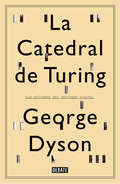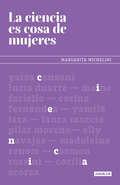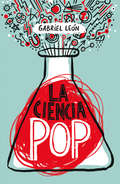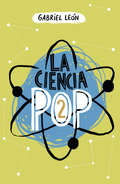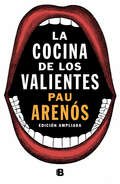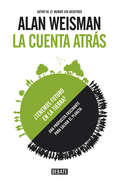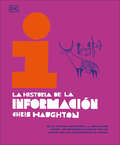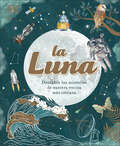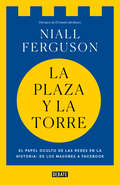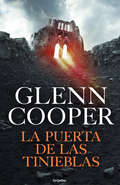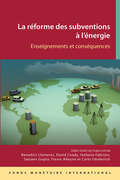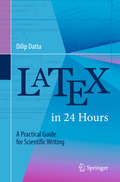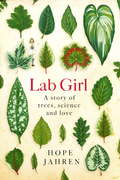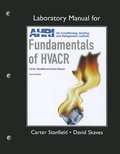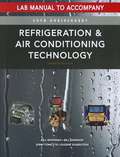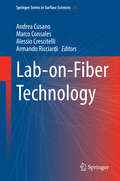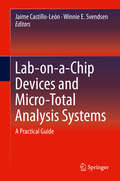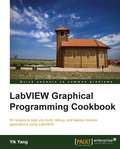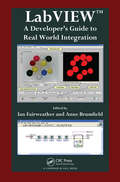- Table View
- List View
La Cyber-psychologie
by Juan Moises de la Serna Raquel Carrasco UgaldeaPréface Dans ce livre, nous aborderons la nouvelle branche appelée Cyber-psychologie, qui étudie le changement qui s’est produit dans la relation individu-technologie, analysant comment les nouveaux développements affectent la vie quotidienne des personnes ainsi que la santé mentale de ses utilisateurs. Le tout est ratifié par une étendue bibliographie basée sur les dernières investigations réalisées dans ce domaine. Les réseaux sociaux, Internet et tout l’avancement technologique de ces dernières années ont changé notre regard sur le monde et notre comportement, un changement radical, dans la plupart des cas, qui ne pouvait pas passer inaperçu pour la Psychologie, la science qui étudie le comportement humain. L’invention et l’utilisation, au début, d’outils comme la hache ou l’aiguille et, postérieurement, de machines comme la voiture ou l’ordinateur ont révolutionné les formes des relations avec soi-même et avec autrui. Pour parler avec un membre de sa famille ou un ami, il suffit de se connecter sur Skype et que l’autre personne soit disponible, indépendamment de l’endroit où elle se trouve. Les progrès technologiques durant ces dernières décennies ont été nombreux et très rapides, ce qui a obligé les personnes, les utilisateurs de cette technologie, à s’adapter à celle-ci pour pouvoir profiter d’elle.
La catedral de Turing: Los orígenes del universo digital
by George Dyson«Es posible inventar una sola máquina que pueda utilizarse para computar cualquier secuencia computable», anunció en 1936 un joven Alan Turing de veinticuatro años. En los años 40 y 50 un reducido grupo de hombres y mujeres, liderado por John von Neumann, se reunió en Princeton, New Jersey, para comenzar la construcción de una de los primeros ordenadores que materializaría la visión de Alan Turing de una máquina universal. Los códigos generados en ese embrión de universo de 5 kilobytes (menos memoria de lo que requiere un solo icono en la pantalla de un ordenador actual) rompieron la distinción entre números que significan cosas y números que hacen cosas, y nuestro universo cambió para siempre. La catedral de Turing es la historia de la invención más constructiva del siglo XX, el ordenador digital, de quiénes y cómo la crearon. Un relato histórico y profético que nos cuenta cómo el código logró conquistar el mundo y se aventura a plantear el futurodel universo digital."No es solo un libro extraordinario sobre ciencia. Es un libro extraordinario, punto." #The Globe and Mail «Si quieres estar mentalmente preparado para la próxima revolución informática, el libro de Dyson es imprescindible. Pero también es imprescindible si solo quieres una historia apasionada de cómo los científicos de verdad (como mínimo algunos) piensan y trabajan.» Literary Review
La ciencia es cosa de mujeres
by Margarita MicheliniLas once científicas uruguayas retratadas en este libro cuentan sus sueños, su día a día, sus logros y sus peajes. No es casualidad que en el nivel más alto del Sistema Nacional de Investigadores haya una mujer por cada 3,4 varones. Tampoco que en los grados iniciales la participación femenina se equipare a la de ellos. Habla de una lógica de obstáculos y prejuicios, más o menos conscientes y vastamente estudiados, que lentamente va cambiando. Las once científicas uruguayas retratadas en este libro cuentan sus sueños, su día a día, sus logros y sus peajes. Estas páginas guardan la esperanza de contagiar a quienes se plantean seguir sus pasos y a los lectores todos, para que puedan darle a su labor el lugar que merece. Sin ellas, la ciencia tendría otro tinte. Trabajan con pasión, la mayoría en silencio, en temas que parecen lejanos y sin embargo repercuten en la vida de todos. Productos naturales que contrarres-ten el uso de plaguicidas, sistemas de información para cuidar el ambiente, el amor por partículas tan imperceptibles como poderosas, el tesón de una loca idea, la estadística aplicada para modelar el comportamiento del SARS-CoV-2 y la carrera para fabricar en Uruguay un kit para detectarlo se cruzan con una científica emprendedora, una doctora del clima especialista en enfrentar temporales, una experta en mecatrónica que hace hablar a las máquinas o una jugadora de elite en las matemáticas. Cuando la creatividad y las neuronas se conjugan con entrega, el resultado no tiene límites.
La ciencia oscura
by GABRIEL LEONCrónica de divulgación científica que relata aquellas investigaciones y experimentos reñidos con la ética, al punto de poner en peligro la salud y la vida de quienes participaron en ellos. Sin tener en cuenta la ética ni el bienestar de hombres y mujeres, la historia de la ciencia acumula experimentos transgresores, crueles y con consecuencias irreparables para quienes participaron en ellos. El divulgador científico más seguido en Chile, Gabriel León, nos presenta investigaciones médicas como las esterilizaciones forzadas, los experimentos dermatológicos en cárceles, la separación al nacer de gemelos idénticos para análisis sicológicos y un largo y horroroso etcétera narrado con la claridad, potencia y los fundamentos que lo han convertido en uno de los autores best sellers de la divulgación científica en Chile.
La ciencia pop
by Gabriel LeonLa ciencia pop es un libro de divulgación apasionante ¿Por qué los tomates lindos son desabridos? ¿Cómo el descubrimiento de un Premio Nobel hizo quebrar un país? ¿Qué tienen que ver las palomas con los misiles y las guerras? ¿De qué están hechos los genes? ¿Cómo fue descubierta la sacarina? ¿Se puede afirmar que las fresas son chilenas? ¿Qué tienen que ver las jibias de la Quinta Región en los avances de la neurobiología? ¿Podemos decir que el agua tiene recuerdos? ¿Que las plantas son inteligentes? El científico chileno Gabriel León aborda estas y otras preguntas y las responde de una manera amena y convincente, para acercanos así a un mundo a veces incógnito y, en el camino, despejar los secretos del planeta y nuestra especie.
La ciencia pop 2
by Gabriel LeonUn compilado de crónicas sobre eventos de la ciencia destinado a un público no especializado Repitiendo la fórmula de su primera versión, Ciencia pop 2 entrega nuevas historias y hazañas científicas. Biografías, descubrimientos, accidentes, errores e incógnitas son abordadas mediante una pluma informada y fascinante. Historias que son capaces de enseñar y, a la vez, de abrir puertas de una materia enigmática y estremecedora, pero al mismo tiempo, presente en todo lo que nos rodea.
La clave secreta del universo: Una maravillosa aventura por el cosmos (La clave secreta del universo #Volumen 1)
by Lucy HawkingCon La clave secreta del Universo el genial Stephen Hawking y su hija Lucy han conseguido acercar a los pequeños -y no tan pequeños- las maravillas y los secretos del Universo, y demostrarnos que la ciencia también puede ser divertida y apasionante. A George nada le gusta más en el mundo que mirar las estrellas; también le encantaría tener un ordenador con el que navegar y conocer más sobre el Universo, pero sabe que eso es misión imposible. En casa, sus padres son tan ecologistas que no quieren ni oír hablar del progreso y la ciencia. Pero lo que ellos no saben es que el enemigo está muy cerca. Acaba de llegar un nuevo vecino que, ¡horror!, es un eminente científico, y eso, para los padres de George, solo significa una cosa: peligro. Si hubieran imaginado lo que le esperaba a su hijo, nunca le habrían dejado entrar en su casa... Reseña:«Se juntan el asombro de un niño con la agudeza intelectual de un genio.»The Sunday Times
La cocina de los valientes (edición actualizada)
by Pau Arenós«El libro definitivo para comprender la cocina contemporánea.»Ferran Adrià Premio Nacional de Gastronomía, premio Juan Mari Arzak y premio a la Excelencia Gastronómica de la Academia Internacional de Gastronomía, Pau Arenós nos brinda, en la presente edición, el libro definitivo sobre la gastronomía contemporánea: una edición ampliada de este libro magistral, publicado en 2011 y reconocido, en 2012, como mejor libro español de historia de la gastronomía. <P><P>Un retrato crítico de la alta cocina contemporánea, cuyas palabras claves son: vanguardia, creatividad, innovación y gallardía. Una extensa reflexión acerca de, entre otros conceptos, el producto, la ecococina, la regeneración de la cocina popular... <P><P>Así como una osada reivindicación de que «la cocina no es para cobardes sino para los valientes del fuego, del nitrógeno líquido y de la brasa, del cuchillo y del robot, del chuletón y de la esferificación.» La crítica ha dicho...«Uno de los más grandes escritores gastronómicos del mundo.»Juan Mari Arzak
La cocina de los valientes (edición actualizada)
by Pau Arenós«El libro definitivo para comprender la cocina contemporánea.»Ferran Adrià Premio Nacional de Gastronomía, premio Juan Mari Arzak y premio a la Excelencia Gastronómica de la Academia Internacional de Gastronomía, Pau Arenós nos brinda, en la presente edición, el libro definitivo sobre la gastronomía contemporánea: una edición ampliada de este libro magistral, publicado en 2011 y reconocido, en 2012, como mejor libro español de historia de la gastronomía. Un retrato crítico de la alta cocina contemporánea, cuyas palabras claves son: vanguardia, creatividad, innovación y gallardía. Una extensa reflexión acerca de, entre otros conceptos, el producto, la ecococina, la regeneración de la cocina popular... Así como una osada reivindicación de que «la cocina no es para cobardes sino para los valientes del fuego, del nitrógeno líquido y de la brasa, del cuchillo y del robot, del chuletón y de la esferificación.» La crítica ha dicho...«Uno de los más grandes escritores gastronómicos del mundo.»Juan Mari Arzak
La corporación
by Rob Hart¿Y si las empresas tecnológicas fueran el verdadero Gran Hermano? Un thriller inquietantemente verosímil sobre el futuro que nos aguarda. El mundo ya no es lo que era. La violencia armada, el desempleo y el cambio climático lo han convertido en un polvorín inhabitable. En medio de todo ese caos, Cloud, una poderosa corporación tecnológica, se erige como salvadora. No solo pretende vender a los ciudadanos cualquier cosa que necesiten, sino convertirse en un hogar para ellos. A cambio, tendrán que trabajar. El trato parece justo, pero las apariencias siempre engañan. Paxton jamás pensó que acabaría empleado como guardia de seguridad en la compañía que arruinó su vida y mucho menos que se mudaría a sus instalaciones. Pero eso es justo lo que ha hecho. Y, teniendo en cuenta cómo se sobrevive fuera, no suena como una mala opción. Allí ha conocido a Zinnia, que podría haberse enamorado de él, pero que tal vez solo esté utilizándole para sus propios fines. Porque en Cloud, pese a su resplandeciente aspecto, nada es lo que parece y ambos van a descubrir lo lejos que la corporación está dispuesta a llegar... para hacer del mundo un lugar mejor. Reseñas:«Una novela totalmente absorbente que te hará olvidar tu plataforma de streaming favorita durante unas cuantas noches.»Stephen King «Un exitazo literario que además rebosa inteligencia. Estremecedoramente cautivador.»The Observer «Emocionante. Conjura una realidad cercana, deformada pero reconocible, que plasma a la perfección la distopía en forma de utopía de nuestras peores pesadillas. Esta novela pone la época actual frente a un oscuro espejo.»San Francisco Chronicle «¿Y si el régimen totalitario que controla la vida de la gente no fuera un gobierno fascista sino una enorme corporación? De esa premisa parte el inteligente y orwelliano thriller ideado por Hart, que imagina un futuro próximo demasiado plausible.»Publishers Weekly «Una historia de suspense que es una gozada y que no podrás dejar de leer. Totalmente recomendado para los fans de las distopías.»Library Journal «Un thriller fascinante con un ritmo increíble que pone el dedo en la llaga.»Booklist «Una brillante sátira distópica. Hart ha creado un convincente y horripilante futuro post-orwelliano, dominado por una única corporación dictatorial.»BBC «Thrillers futuristas como 1984, Fahrenheit 451 y El cuento de la criada se convierten en éxitos porque la trama esconde más de unas cuantas pepitas de verdad que hacen que la historia sea creíble. Añade el inteligente thriller de Rob Hart La corporación a esa lista. No solo tienes la impresión de que su absorbente trama podría hacerse realidad, sino que de cierta manera lo está haciendo ya.»Associated Press «Imagina que un día jodemos tanto el mundo que todos nos vemos obligados a vivir en el lugar en el que trabajamos en una especie de equivalente moderno de la esclavitud, añádele un thriller ambientado en una compañía tecnológica decidida a imponer su ley, y aun así todavía no serás consciente de lo inteligente y a la vez aterrador que es este libro. Tenso y magistral.»Chuck Wendig
La cuenta atrás: ¿Tenemos futuro en la tierra?
by Alan WeismanUna propuesta fascinante para salvar el planeta. La cuenta atrás es un libro audaz, inteligente y provocador, que nos explica cuáles son los efectos de nuestro desmesurado crecimiento demográfico y plantea la alternativa más rápida y razonable para restaurar el equilibrio. Una investigación de conclusiones revolucionarias que cambiará la manera en que vemos nuestras vidas y nuestro destino. El crecimiento de la población mundial se ha disparado hasta límites insostenibles: dado que cada cuatro días y medio nace un millón de personas más en un planeta finito, la población actual precisaría de los recursos de tres Tierras para alcanzar un nivel de vida semejante al de los países desarrollados, y con el sobrecalentamiento de la atmósfera y las alteraciones de los océanos, las perspectivas de un futuro sostenible para la humanidad son cada vez más dudosas. Weisman ha recorrido todo el planeta para hablar con personasque viven bajo sistemas políticos distintos, y para saber cómo viven y qué piensan gentes de distintas nacionalidades, culturas y religiones. Quiere conocer para poder dar respuesta a las preguntas que, según todos los expertos, son las más importantes y también las más difíciles de responder.
La historia de la información (The History of Information): De las pinturas rupestres a la revolución digital: un recorrido ilustrado por los avances que han transformado el mundo
by Chris HaughtonEmprende junto a tus hijos un inolvidable recorrido por la historia global de la información y la comunicación.¿Qué es lo que hace que la tecnología no caiga en desuso y esté en constante desarrollo? La respuesta es: ¡la información! La manera en la que almacenamos y compartimos información ha cambiado mucho a lo largo de la historia y ha jugado un papel fundamental en la evolución de todos los aspectos de nuestra sociedad, como el social, el político o el económico.Pasa las páginas de esta enciclopedia para descubrir cómo el desarrollo de la comunicación y la recopilación de datos e información nos ha llevado al progreso tecnológico y a la vida tal y cómo la conocemos.En su interior, encontrarás: La historia de la información y la comunicación, desde el surgimiento de los primeros idiomas y las pinturas rupestres hasta las diferentes formas en las que nos comunicamos hoy en día. Contenido escrito por el autor e ilustrador mundialmente famoso y ganador de múltiples premios, Chris Haughton.Explicaciones y datos sobre los conceptos, sistemas y herramientas más actuales, como la inteligencia artificial, el Big Tech, el Big Data o el “hacerse viral” en redes sociales. Diseño moderno con ilustraciones llamativas y divertidas. Conoce cada detalle del origen del lenguaje oral y escrito, las formas en las que se ha transmitido y registrado la información a lo largo de los años, y cómo todo esto ha ayudado al ser humano a lo largo de la historia. Un libro imprescindible para aprender lo importantes que son y han sido la comunicación y la información en nuestras vidas.-------------------------------------------Take children on an illuminating journey through the evolution of knowledge and communication with the debut non-fiction book by best-selling author Chris Haughton.Discover how the ways we share and store information have shaped and changed the world in this utterly unique book for adults and children. What is it that makes technology improve rather than stay static or even fall into decline? The answer is information.Celebrate your child's curiosity in this book of information, offering: A beautiful look at the story of information; from the first languages and cave paintings through to how we communicate and record information today.Content written by world famous and multi-award winning author and illustrator, Chris Haughton.A global journey throughout history from the origination of language, how information has been passed on and recorded, how this has helped humans.This book tells the story of how we came to collect information, and what it means for us. The ability to record information in the form of writing and collecting data has caused an explosion of technological progress.
La luna (The Moon): Descubre los misterios de nuestra vecina más cercana
by Dr. Sanlyn Buxner- Las impresionantes ilustraciones hacen de este título un regalo perfecto.- Un libro repleto de información y curiosidades sobre la luna con imágenes sorprendentes.Un precioso libro ilustrado para aprender todo sobre la luna.Conoce el relieve de la luna, las fases lunares, la historia de las misiones de la NASA, el efecto de la luna en las mareas y en los animales nocturnos, los recientes descubrimientos científicos y mucho más.Con información detallada, fotografías, imágenes, ilustraciones y diagramas. Los niños pueden descubrir el pasado, el presente y el futuro de la luna.------------------------------------ A beautiful book focused entirely on La luna.- Covers the entire subject of the moon with incredible facts and images.A beautiful book focused entirely on the moon.Covers the entire subject of the moon – including its formation and geography, the lunar phases, a history of NASA&’s Apollo missions, its effect on Earth&’s tides and nocturnal animals, its place in our mythology, plenty of recent scientific discoveries, and more.
La mujer perfecta
by J.P. DelaneyLa vida perfecta. El amor perfecto. La mentira perfecta.El nuevo y sorprendente thriller del autor de La chica de antes. Hace cinco años, Abbie Cullen desapareció en extrañas circunstancias. Fue un golpe tan terrible para su marido, Tim Scott, empresario de éxito fundador de una de las start-ups más innovadoras de Silicon Valley, que decidió dedicarse en cuerpo y alma a recuperar a su esposa. Y lo consiguió. Abbie se despierta en las oficinas de Tim aturdida y confusa, no sabe quién es ni recuerda cómo ha llegado hasta allí. Él le cuenta que es una artista de gran talento, una deportista que adora practicar el surf y una madre cariñosa para Danny. Le dice que cinco años atrás sufrió un terrible accidente y que gracias a un impresionante avance tecnológico ha podido recuperarla. A medida que Abbie reconstruye los recuerdos de su matrimonio comienza a cuestionar a su marido y su versión de lo ocurrido. ¿Qué pasó realmente? ¿Puede confiar en su esposo cuando dice que quiere que estén juntos para siempre? Reseñas:«Un viaje cautivador y profundamente fascinante.»The Independent «Un thriller psicológico de lectura compulsiva.»Publishers Weekly «Algunas parejas parecen ser perfectas, pero ¿hay alguna relación perfecta? Intrigante, escalofriante.»Portland Press Herald «JP Delaney se ha superado a sí mismo con su último thriller, dinámico, afilado y estimulante. La mujer perfecta es una novela de suspense vanguardista, diferente a cualquier otra que hayas leído antes. ¡Una lectura obligada!»Mary Kubica, The Good Girl «Un thriller psicológico retorcido y completamente original, que te atrapa desde el principio y no te suelta hasta el final».Karen Cleveland, Toda la verdad «Real, sorprendente, increíblemente brillante. [...] Lo devoré.»C. J. Tudor, El hombre de tiza «Los lectores [...] serán recompensados con una nueva versión de thriller psicológico que les dejará satisfechos.»Booklist «No sé lo que esperaba, pero no era esto. Me encantan los libros de J.P. Delaney, y creo que este podría ser el mejor de todos. Es terriblemente plausible. Una idea increíblemente original, devastadora e inteligente, complicada y retorcida.»Goodreads «Una novela extraordinaria que realmente merece la descripción de thriller psicológico. Es estimulante e inteligente, además de muy entretenida.»Goodreads Sobre La chica de antes:«Original y absorbente.»The Times «Suspense psicológico de gran nivel.»The Bookseller «Subyugante.»Publishers Weekly
La plaza y la torre: Redes y poder: de los masones a Facebook
by Niall FergusonUna historia de las redes organizacionales que han cambiado el mundo y una invitación a la reflexión escéptica sobre el papel que tienen en nuestra sociedad. La mayor parte de la historia es jerárquica: tiene que ver con papas, presidentes o primeros ministros. Pero, ¿y si fuera así por el simple hecho de que han sido ellos los que han creado los archivos históricos? ¿Y si estuviéramos omitiendo y relegando la influencia de poderosas pero menos visibles redes de organización? El siglo XXI ha sido proclamado como la Era de la Red, pero en este libro Niall Ferguson nos recuerda que las redes sociales no tienen nada de novedoso. Desde el tiempo de las imprentas y los predicadores que llevaron a cabo la Reforma hasta los masones que lideraron la Revolución estadunidense, fueron las redes organizacionales quienes interrumpieron el orden establecido. Así pues, lejos de ser una novedad, nuestra era es más bien la Segunda Era de la Red, con el ordenador ocupando el papel central que en su momento ocupó el papel impreso. Quienes esperan una utopía de «internautas» interconectados pueden, por lo tanto, sentirse decepcionados. Las redes son propensas a la agrupación, los contagios, pero ante todo a las interrupciones y los conflictos del pasado encuentran paralelismos desconcertantes hoy, en el tiempo de Facebook, el Estado Islámico y el mundo trumpiano. Este maravilloso libro revela la historia oculta de las redes organizacionales que han cambiado el rumbo de la historia y se presenta a la vez como un antídoto hacia las teorías de la conspiración y un desafío a la historiografía tradicional que nunca han prestado demasiada atención a las redes informales de influencia. Reseñas:«Cautivante y convincente.»The New York Times «Niall Ferguson ha escrito nuevamente un brillante libro... En 400 páginas habrás reabastecido tu mente. Hazlo.»The Wall Street Journal «Ferguson nos recuerda que la red social no surgió completa de la mente de Mark Zuckerberg; más bien, es una fuerza persistente en los asuntos humanos que ofrece una lente novedosa sobre el pasado y el desconcertante presente.»San Francisco Chronicle
La puerta de las Tinieblas (Trilogía Condenados #Volumen 2)
by Glenn CooperImagina un mundo similar al nuestro, pero completamente distinto. Un mundo poblado por los personajes más abyectos de la Historia.Ese mundo es el Infierno y tu única opción es volver. Historia, intriga, acción, aventura y ciencia se aúnan en La puerta de las tinieblas, la nueva entrega de Glenn Cooper, el autor de referencia del thriller histórico. Apenas ha durado la esperanza. La esperanza de olvidarse del cielo plomizo y la atmósfera opresiva de Abajo. La esperanza de haber dejado atrás, para siempre, el mundo donde han sido confinados todos los personajes más abyectos que una vez pisaron la Tierra. En cuanto John Camp y la doctora en física Emily Loughty se encuentran de vuelta en el laboratorio secreto de Dartford, tienen que aceptar una realidad escalofriante: la pesadilla no ha terminado. Como ellos preveían, la puesta en marcha del colisionador de partículas volvió a abrir el corredor que había conectado ambos mundos y les permitió regresar. Pero también abrió otras brechas, abduciendo a inocentes y trayendo a este mundo a hombres y mujeres que jamás imaginaron que podrían escapar de su condena eterna. En Londres, hay quien está dispuesto a desenmascarar las mentiras del gobierno sobre lo que está sucediendo en el laboratorio, y un agente del MI5 empieza una carrera contrarreloj para localizar a los criminales que han retornado a la Tierra. Mientras, John y Emily se preparan para afrontar un viaje más peligroso que el anterior. Un viaje en el que combatirán contra temibles enemigos y establecerán nuevas alianzas. Pero ¿es sensato confiar en quienes sucumbieron al hechizo del mal? La puerta de las tinieblas es la segunda entrega de la trilogía «Condenados». Una novela absorbente y una historia asombrosa, oscura y brutal a la vez que absolutamente fascinante. Glenn Cooper demuestra una vez más su maestría para sumergirnos en un thriller trepidante que mantiene al lector pegado a sus páginas.
La réforme des subventions à l'énergie: Enseignements et conséquences
by International Monetary FundA report from the International Monetary Fund.
LaTeX in 24 Hours
by Dilip DattaThis book presents direct and concise explanations and examples to many LaTeX syntax and structures, allowing students and researchers to quickly understand the basics that are required for writing and preparing book manuscripts, journal articles, reports, presentation slides and academic theses and dissertations for publication. Unlike most literature and guides currently available on LaTeX, which takes a more technical stance, focusing on the details of the software itself, the author presents this user-focused guide that is concerned with its application to everyday tasks and scenarios, which is packed with exercises and looks at topics like formatting text, drawing and inserting tables and figures, bibliographies and indexes, equations, slides, and provides valuable explanations to error and warning messages so you can get work done with the least time and effort needed. This means LaTeX in 24 Hours can be used by students and researchers with little or no previous experience with LaTeX to gain quick and noticeable results, as well as being used as a quick reference guide for those more experienced who want to refresh their knowledge on the subject.
Lab Girl: A Story Of Trees, Science And Love
by Hope JahrenLab Girl is a book about work and about love, and the mountains that can be moved when those two things come together. It is told through Jahren's remarkable stories: about the discoveries she has made in her lab, as well as her struggle to get there; about her childhood playing in her father's laboratory; about how lab work became a sanctuary for both her heart and her hands; about Bill, the brilliant, wounded man who became her loyal colleague and best friend; about their field trips - sometimes authorised, sometimes very much not - that took them from the Midwest across the USA, to Norway and to Ireland, from the pale skies of North Pole to tropical Hawaii; and about her constant striving to do and be her best, and her unswerving dedication to her life's work.Visceral, intimate, gloriously candid and sometimes extremely funny, Jahren's descriptions of her work, her intense relationship with the plants, seeds and soil she studies, and her insights on nature enliven every page of this thrilling book. In Lab Girl, we see anew the complicated power of the natural world, and the power that can come from facing with bravery and conviction the challenge of discovering who you are.
Lab Manual for Fundamentals of HVACR (Second Edition)
by Carter Ahri Carter Stanfield David SkavesThis is a student supplement associated with: Fundamentals of HVACR, 2/e Carter Stanfield David Skaves AHRI ISBN: 0132859610
Lab Manual to Accompany Refrigeration and Air Conditioning Technology: Concepts, Procedures, and Troubleshooting Techniques
by John A. Tomczyk William C. Whitman William M. JohnsonGive your students the hands-on practice and insights to support the concepts from this edition of the text with this proven lab manual. Each unit correlates with a unit in the text, and contains an overview, key terms, review test and Lab Exercises where applicable.
Lab-on-Fiber Technology
by Andrea Cusano Marco Consales Alessio Crescitelli Armando RicciardiThis book focuses on a research field that is rapidly emerging as one of the most promising ones for the global optics and photonics community: the "lab-on-fiber" technology. Inspired by the well-established "lab on-a-chip" concept, this new technology essentially envisages novel and highly functionalized devices completely integrated into a single optical fiber for both communication and sensing applications. Based on the R&D experience of some of the world's leading authorities in the fields of optics, photonics, nanotechnology, and material science, this book provides a broad and accurate description of the main developments and achievements in the lab-on-fiber technology roadmap, also highlighting the new perspectives and challenges to be faced. This book is essential for scientists interested in the cutting-edge fiber optic technology, but also for graduate students.
Lab-on-a-Chip Devices and Micro-Total Analysis Systems
by Jaime Castillo-León Winnie E. SvendsenThis book covers all the steps in order to fabricate a lab-on-a-chip device starting from the idea, the design, simulation, fabrication and final evaluation. Additionally, it includes basic theory on microfluidics essential to understand how fluids behave at such reduced scale. Examples of successful histories of lab-on-a-chip systems that made an impact in fields like biomedicine and life sciences are also provided. This book also: · Provides readers with a unique approach and toolset for lab-on-a-chip development in terms of materials, fabrication techniques, and components · Discusses novel materials and techniques, such as paper-based devices and synthesis of chemical compounds on-chip · Covers the four key aspects of development: basic theory, design, fabrication, and testing · Provides readers with a comprehensive list of the most important journals, blogs, forums, and conferences where microfluidics and lab-on-a-chip news, methods, techniques and challenges are presented and discussed, as well as a list of companies providing design and simulation support, components, and/or developing lab-on-a-chip and microfluidic devices.
LabVIEW Graphical Programming Cookbook
by Yik YangThis practical and realistic guide will give you independent recipes, concentrating on advanced level concepts so that you can make your applications. If you are a developer, scientist, or engineer who uses LabVIEW to test, develop and manage advanced level applications, then this is the book for you. Prerequisites include proficiency in C or C++, and workable knowledge of LabVIEW.
LabVIEW: A Developer's Guide to Real World Integration
by Ian Fairweather Anne BrumfieldLabVIEW™ has become one of the preeminent platforms for the development of data acquisition and data analysis programs. LabVIEW™: A Developer’s Guide to Real World Integration explains how to integrate LabVIEW into real-life applications.Written by experienced LabVIEW developers and engineers, the book describes how LabVIEW has been pivotal in solving real-world challenges. Each chapter is self-contained and demonstrates the power and simplicity of LabVIEW in various applications, from image processing to solar tracking systems. Many of the chapters explore how exciting new technologies can be implemented in LabVIEW to enable novel solutions to new or existing problems. The text also presents novel tricks and tips for integrating LabVIEW with third-party hardware and software.Ideal for LabVIEW users who develop stand-alone applications, this down-to-earth guide shows how LabVIEW provides solutions to a variety of application problems. It includes projects and virtual instrumentation for most of the programs and utilities described. Many of the authors’ own software contributions are available on the downloadable resources.

